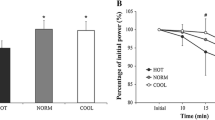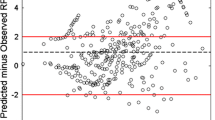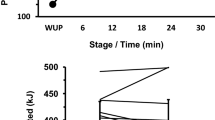Summary
The effects of hot and cool environments on perceptual and physiological responses during steady-state exercise were examined in men (n = 14) performing 30 min of constant exercise (cycle ergometry) at a perceived exertion of “somewhat hard”. Subjects exercised at the same absolute exercise intensity in hot (40°C), neutral (24°C), and cool (8°C) conditions. Data were collected for differential ratings of perceived exertion (RPE), affect, thermal sensation, mean skin (\(\bar T_{{\text{sk}}} \)) (and rectal temperatures (T re), and cardiac frequency (fc). The subjects completed the hot exposure with an average {ei174-2}sk of 37.5°C (SEM 0.11), while the neutral and cool conditions produced values of 33.8 (SEM 0.09) and 28.2°C (SEM 0.30), respectively. The \(\bar T_{{\text{sk}}} \) was significantly higher in the hot than the neutral and cool conditions throughout exercise (P < 0.05). The fc was significantly lower in the cool than in the other conditions (P < 0.05), and the subjects completed the hot exposure with a mean fc more than 20 beats · min−1 greater than observed in the other conditions. The subjects felt worse (lower affect) in the heat throughout exercise (P < 0.05). Overall RPE was significantly lower in the cool than in the heat, while chest RPE scores for the cool and hot conditions were displaced vertically by approximately two points. Subjects perceived work to be harder, felt worse, and experienced greater thermal sensation in the hot condition, compared with the neutral and cool conditions. Changes in cutaneous vasomotor tone and heat-induced influences on the chest may have accounted for the RPE changes observed in the heat.
Similar content being viewed by others
References
Baron RA (1977) Human aggression. Plenum Press, New York
Borg GAV (1961) Perceived exertion in relation to physical work load and pulse rate. K Fysiogr Saellsk Lund Foerh 31:105–115
Borg GAV (1962) Physical performance and perceived exertion. Gleerup, Lund
Borg GAV (1982) Psychophysical bases of perceived exertion. Med Sci Sports Exerc 14:377–381
Boutcher SH, Fleischer-Curtian LA, Gines SD (1988) The effects of self presentation on perceived exertion. J Sport Exerc Psychol 10:270–280
Boutcher SH, Seip RL, Hetzler RK, Pierce EF, Snead D, Weltman A (1989) The effects of specificity of training on rating of perceived exertion at the lactate threshold. Eur J Appl Physiol 59:365–369
Carton RL, Rhodes EC (1985) The effects of endurance training upon ratings of perceived exertion. Aust J Sci Med Sport 17(4):19–24
Crawshaw LI, Nadel ER, Stolwijk JAJ, Stamford BA (1975) Effect of local cooling on sweating rate and cold sensation. Pflügers Arch 354:19–27
Davies CTM, Sargent AJ (1979) The effects of atropine and practolol on the perception of exertion during treadmill exercise. Ergonomics 22:1141–1146
Gagge AP, Winslow CEA, Herrington LP (1938) Influence of clothing on the physiological reactions of the human body to varying environmental temperatures. Am J Physiol 124:30–50
Gagge AP, Stolwijk JAJ, Hardy JD (1967) Comfort and thermal sensations and associated physiological responses at various ambient temperatures. Environ Res 1:1–20
Geisser S, Greenhouse SW (1958) An extension of Box's results on the use of the F distribution in multivariate analysis. Ann Math Stat 29:885–891
Hardy JD (1961) Physiology of temperature regulation. Physiol Rev 41:521–606
Hardy JD (1970) Thermal comfort: skin temperature and physiological thermoregulation. In: Hardy JD, Gagge AP, Stolwijk JAJ (eds) Physiological and behavioral temperature regulation. Thomas, Springfield, Ill.
Hardy CJ, Rejeski WJ (1989) Not what, but how one feels: the measurement of affect during exercise. J Sport Exerc Psychol 11:304–317
Hill DW, Cureton KJ, Grisham C, Collins MA (1987) Effect of training on the rating of perceived exertion at the ventilatory threshold. Eur J Appl Physiol 56:206–211
ISO (1992) Evaluation of thermal strain by physiological measurements. International Standards Organisation, Geneva ISO 9886: 1992 [E]
Kamon E, Pandolf K, Cafarelli E (1974) The relationship between perceptual information and physiological responses to exercise in the heat. J Hum Ergol 3:45–54
Kuoppasalmi K, Ilmarinen R, Smolander J, Harkonen M, Korhonen O (1986) Relationship between physiological responses and perceived exertion of muscular exercise under various environmental conditions. Psychiatr Fenn [Suppl]:69–77
Maw G, Taylor NAS (1992) Dissociation of rectal and aural temperatures during lower-body exercise. Physiologist 35:175
Morgan WP, Raven PB, Drinkwater BL, Horvath SM (1973) Perceptual and metabolic responsivity to standard bicycle ergometry following various hypnotic suggestions. Int J Clin Exp Hypn 21:86–101
Myers JL (1979) Fundamentals of experimental design (3rd ed) Allyn and Bacon, Boston
Nadel ER, Mitchell JW, Stolwijk JAJ (1973) Differential thermal sensitivity in the human skin. Pflügers Arch 340:71–76
Nelson TM, McIntyre JWR, LaBrie IG, Csiky A (1991) Self-perception of the ability to work in the cold. Behav Med 17:15–23
Nielsen M (1938) Die Regulation der Körpertemperatur bei Muskelarbeit. Skand Arch Physiol 79:193–230
Pandolf KB (1978) Influence of local and central factors in dominating rated perceived exertion during physical work. Percept Mot Skills 46:683–698
Pandolf KB (1983) Advances in the study and application of perceived exertion. Exerc Sport Sci Rev 11:118–158
Rejeski WJ (1985) Perceived exertion: an active or passive process? J Sport Psychol 7:371–378
Rejeski WJ, Ribisl P (1980) Expected task duration and perceived effort: an attributional analysis. J Sport Psychol 2:227–236
Saltin B, Hermansen L (1966) Esophageal, rectal, and muscle temperature during exercise. J Appl Physiol 21:1757–1762
Stevens JC, Adair ER, Marks LE (1970) Pain, discomfort, and warmth as functions of thermal intensity. In: Hardy JD, Gagge AP, Stolwijk JAJ (eds) Physiological and behavioral temperature regulation. Thomas, Springfield, Ill.
Sutton JR, Bar-Or O (1980) Thermal illness in fun running. Am Heart J 100:778–781
Toner MM, Drolet LL, Pandolf KB (1986) Perceptual and physiological responses during exercise in cool and cold water. Percept Mot Skills 62:211–220
Young AJ, Sawka MN, Epstein Y, DeCristofano B, Pandolf K (1982) Cooling different body surfaces during upper and lower body exercise. J Appl Physiol 63:1218–1223
Author information
Authors and Affiliations
Rights and permissions
About this article
Cite this article
Maw, G.J., Boutcher, S.H. & Taylor, N.A.S. Ratings of perceived exertion and affect in hot and cool environments. Europ. J. Appl. Physiol. 67, 174–179 (1993). https://doi.org/10.1007/BF00376663
Accepted:
Issue Date:
DOI: https://doi.org/10.1007/BF00376663




